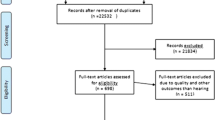Abstract
The primary purpose of this study was to investigate the potential role of transient-evoked Otoacoustic emissions (TEOAEs) beyond screening for hearing impairment in different middle/inner ear disorders in 3–65 years age group. Because TEOAEs are present in ears with normal cochlear and middle ear function and typically are absent or reduced in ears with cochlear and/or middle ear disorders of even mild degree. This was a prospective study of four hundred cases. Out of these 364 cases were having problems related to otology and 36 were healthy volunteers who attended the department of otorhinolaryngology of our institute. All the cases were kept in different eight groups and then subjected to Otoacoustic emission testing with the ‘GSI AUDIO screener’ equipment installed in our ENT department. The data obtained in all groups were analyzed and conclusion was made. TEOAEs is a reliable, simple and cost effective screening technique for hearing disorders with sensitivity varying from 72 to 96.42 % among the study groups and 88 % in composite group comprising all study groups.
Similar content being viewed by others
References
Durrant JD, Campbell K et al (2009) Position statement and clinical practice guideline: ototoxicity monitoring. Am Acad Audiol 1–25
Brownell WE (1990) Outer hair cell electromotility and otoacoustic emissions. Ear Hear 11(2):82–92
Ceranic BJ, Prasher DK, Luxon LM (1998) Presence of tinnitus indicated by variable spontaneous otoacoustic emissions. Audiol Neurootol 3(5):332–344
Gorga MP, Neely ST, Ohlrich B, Hoover B, Redner J (1997) From laboratory to clinic: a large scale study of distortion product otoacoustic emissions in ears with normal hearing and ears with hearing loss. Ear Hear 18:440–455
Hall J (2000) Handbook of otoacoustic emissions. Singular Publishing Group Thomson Learning, New York
Kemp DT (1978) Stimulated acoustic emissions from within the human auditory system. J Acoust Soc Am 64:1386–1391
Shehata WE, Brownell WE, Dieler R (1991) Effects of salicylate on shape, electromotility and membrane characteristics of isolated outer hair cells from guinea pig cochlea. Acta Otolaryngol 111(3):707–718
Stach B (2003) Comprehensive dictionary of audiology illustrated, 2nd edn. Thomson Delmar Learning, New York
Stavroulaki P, Vossinakis IC, Dinopoulou D, Doudounakis S, Adamopoulos G, Apostolopoulos N (2002) Otoacoustic emissions for monitoring aminoglycoside-induced ototoxicity in children with cystic fibrosis. Arch Otolaryngol Head Neck Surg 128:150–155
Swabey, M.A., Beeby, S. P., Brown, A.D., Chad, J. (2004). Using otoacoustic emissions as a biometric
Van Huffelen WM, Mateijsen NJM, Wit HP (1998) Classification of patients with Meniere’s disease using otoacoustic emissions. Audiol Neuro-Otol 3:419–430
Conflict of interest
None.
Author information
Authors and Affiliations
Corresponding author
Rights and permissions
About this article
Cite this article
Meena, R.S., Meena, D., Babu, D. et al. Role of Transient Evoked Otoacoustic Emission Beyond Screening of Hearing Impairment: A Study of 400 Cases. Indian J Otolaryngol Head Neck Surg 65, 134–139 (2013). https://doi.org/10.1007/s12070-012-0597-3
Received:
Accepted:
Published:
Issue Date:
DOI: https://doi.org/10.1007/s12070-012-0597-3




